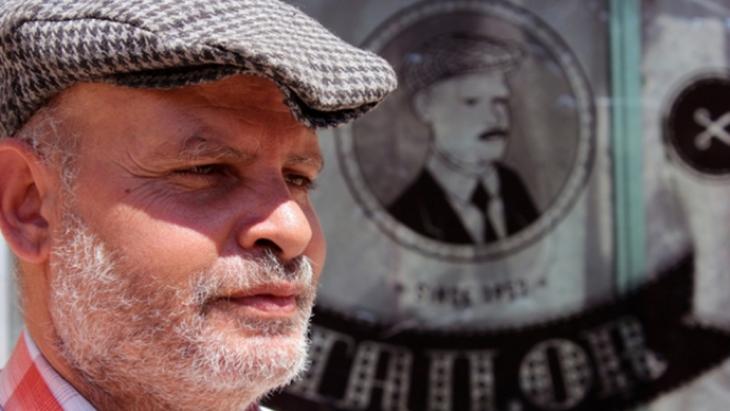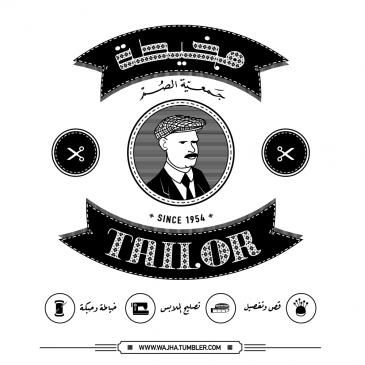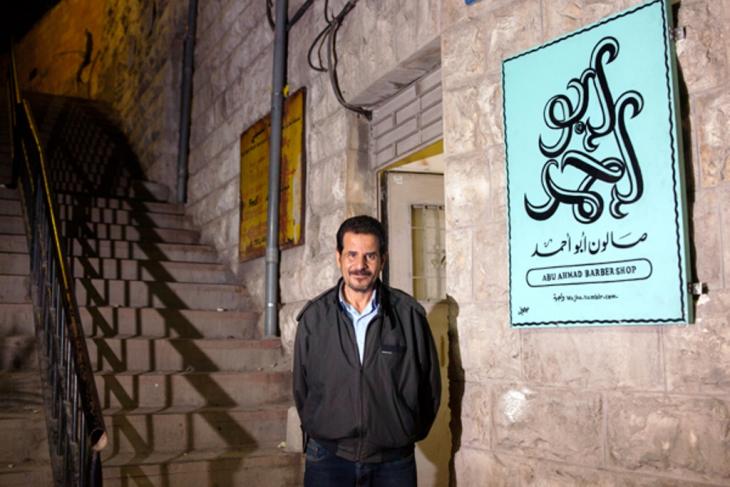A facelift for Amman's artisanal businesses

An eye-catching logo is affixed to the narrow shop window. There are two lines of writing above and below: "Tailor since 1957" in Arabic and English. The words frame the sketched figure of a man with a moustache wearing a checked cap.
Inside the shop – a hotchpotch of materials, threads, pins and drawings – Khaled, the man with the checked cap, sits at a sewing machine. His shop is located in Jabal Al-Nuzha, one of the poorer districts of the Jordanian capital Amman. He has being working there for decades. Almost all that time, his tailor's shop has been inconspicuous, like so many others in an alleyway full of grey house fronts. But then came the logo with the cap, and Khaled's tiny workshop became the neighbourhood attraction.
A custom-made logo and lettering – an attractive visual image – would usually be unaffordable for a one-man artisan business such as this. Hussein Alazaat (32) and Ali Almasri (27) both graphic designers from Amman, want to change all that. Their strategy: to give traditional businesses and shops a facelift with custom-made lettering and individual logos reflecting the character of the relevant owner and tailored to the needs of his business – at no cost to the owners.
Endangered artisan trades
In the past, small businessmen like Khaled gave no thought to the question of image, says Alazaat. "Small businesses are unaware of the economic effect of design, and its influence on customers and buyers," he continues.
But this wasn't always the case. In the Arab business world, the 1950s and 1960s were a golden age for sign writers and painters, precursors to the graphic designers of today. But the craft died out with the onset of the computer age, when the artwork began to be done on the computer instead of by hand. "This created a crazy jumble of lettering and symbols," says Alazaat, adding that modern-day Amman suffers from "visual pollution".
Together with his colleague Almasri, he has been working to address this problem for the past two years. It all began with Khaled, the tailor from Jabal Al-Nuzha. Alazaat grew up in the neighbourhood, and his parents still live there. "Altering shirts and turning up trousers doesn't cost much here and Khaled was only just earning enough to pay the rent on his shop," says Alazaat. "At some point we wondered: how can we help him, with our design know-how and our experience of creating a brand image?"
A fresh look at calligraphy

Their response: Khaled's business needed to become more visible; the shop window needed a logo. The two designers came up with a kind of retro-style coat of arms. The key focus of the design is, however, the owner's trademark cap. The lettering is also custom-made, the letters drawn in a pattern reminiscent of fabric. "Playing with calligraphy, the revival of Arab typographical art is the central element of our work," says Almasri.
Alazaat says the tailor shop's new image had an immediate impact, and suddenly the entire neighbourhood was talking about Khaled's shop: "But for him, all this new attention wasn't just about increasing turnover, it was mostly about recognition. As a result of our project, he felt he and his work were being appreciated again." For the creative duo this was proof that design can also serve a social function as well as an entrepreneurial one. Inspired by the success of their tailor shop project, the two went on to found "Wajha" in 2012, an independent design initiative for small businesses. "Wajha" is the Arab word for "façade". "It's the first thing a customer notices about a business," explains Alazaat. "The façade of a shop is the communication vehicle through which the owner strikes up a relationship with passers-by."
Innovative solutions
This was a problem for barber Abu Ahmad. His shop doesn't have a window at the front, and is hidden away on one of the large number of narrow stepped alleyways linking the old town of Amman with neighbouring districts. Alazaat and Almasri solved the problem by using the passage itself as a façade. They sprayed graffiti on the steps and walls, signs with the words "Barber xx metres from here" in six languages, as well as symbols such as scissors, comb and a razor on walls in the surrounding area, creating a path that led to the salon from several different directions.
Abu Ahmad, a 50-year-old Palestinian who's been running the gentlemen's salon for 10 years, loves the new image and the effect it's having on business: "Since the pictures and signs were put up, I'm getting plenty more customers, recently even tourists," he says.
But the barber had no say in the design process. And this is generally the case with "Wajha" projects. The business owners are not even allowed to look at the final concept, says Almasri. "We're the design experts. We come up with a concept that we think is suitable. And that's exactly how we implement it." So far, the strategy has been a success. This is due to a simple principle: the shop or business owners receive a design in which they themselves play the key role.

It works because Alazaat and Almasri try to fathom the character of the owner: "We ask questions about his family and hobbies, his hopes and dreams." The proprietor of a bookshop, for example, divulged that fishing was his greatest passion. The designers came up with a logo showing a man angling. For fish. Or for something new to read.
While the tailor shop project was concerned only with the shop window, Alazaat and Almasri created an entire corporate identity for the bookseller – but for a low price. The package comes in the form of a single stamp, and now the bookshop owner prints everything out himself, from business cards, to letterheads, to bookmarks.
Free creative services
Alazaat and Almasri offer their individually tailored ideas and creative services to small businesses free of charge. The material costs are minimal and the two work on the projects alongside their regular jobs in a graphic design agency. However, the young designers also benefit from their initiative. On the one hand because it is helping them make a name for themselves in the city and advertising community. On the other, because as they work together with other creative people, which broaden their own experience and training.
They work with people such as the oldest sign painter in Amman, for example. He took the designs conceived on the computer by the pair, and using a brush and oil paint turned them into a sign in the style of a classic shop sign made of metal. "We showed him our designs on a smartphone and explained our concept," says Almasri. "It was a clash of cultures, and sometimes difficult. But we also learned a great deal at the same time, which is useful to us in our everyday work."
Meanwhile the "Wajha" initiative continues to grow, with a number of projects in the pipeline including a bakery, grocery shop, carpentry workshop and forge – all businesses in need of a boost owned by people known to Alazaat and Almasri through family and friends. "Being a designer is not just a profession," says Alazaat. "A designer is also responsible for the milieu in which he lives." "Wajha" won't be able to change the world, but the facades of Amman, for sure.
Daniela Schroeder
© Qantara.de 2014
Translated from the German by Nina Coon
Editor: Aingeal Flanagan/Qantara.de